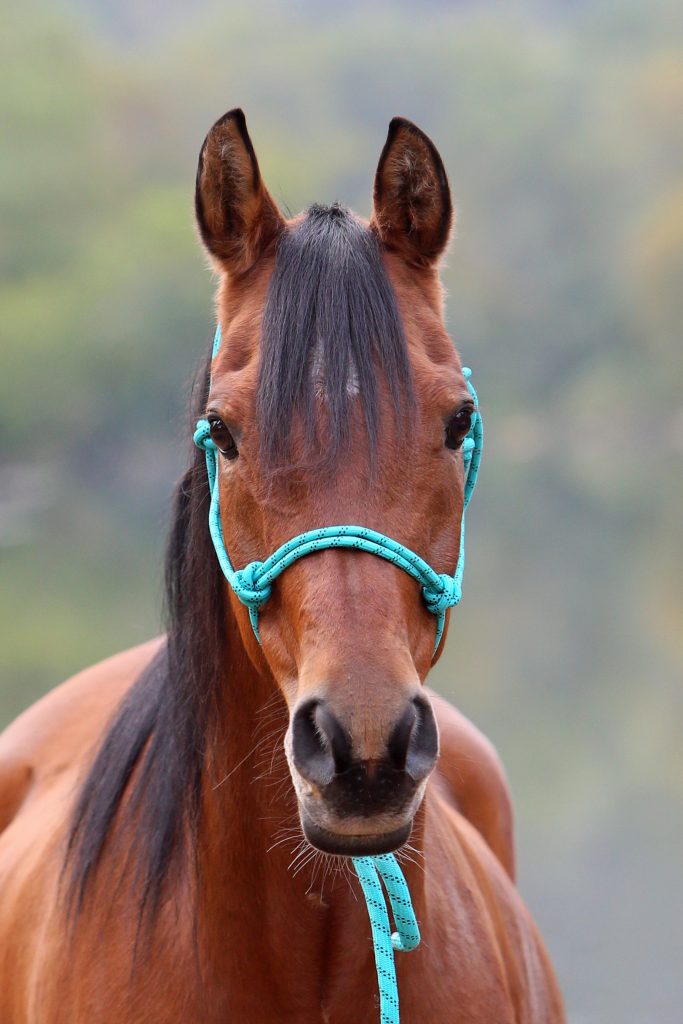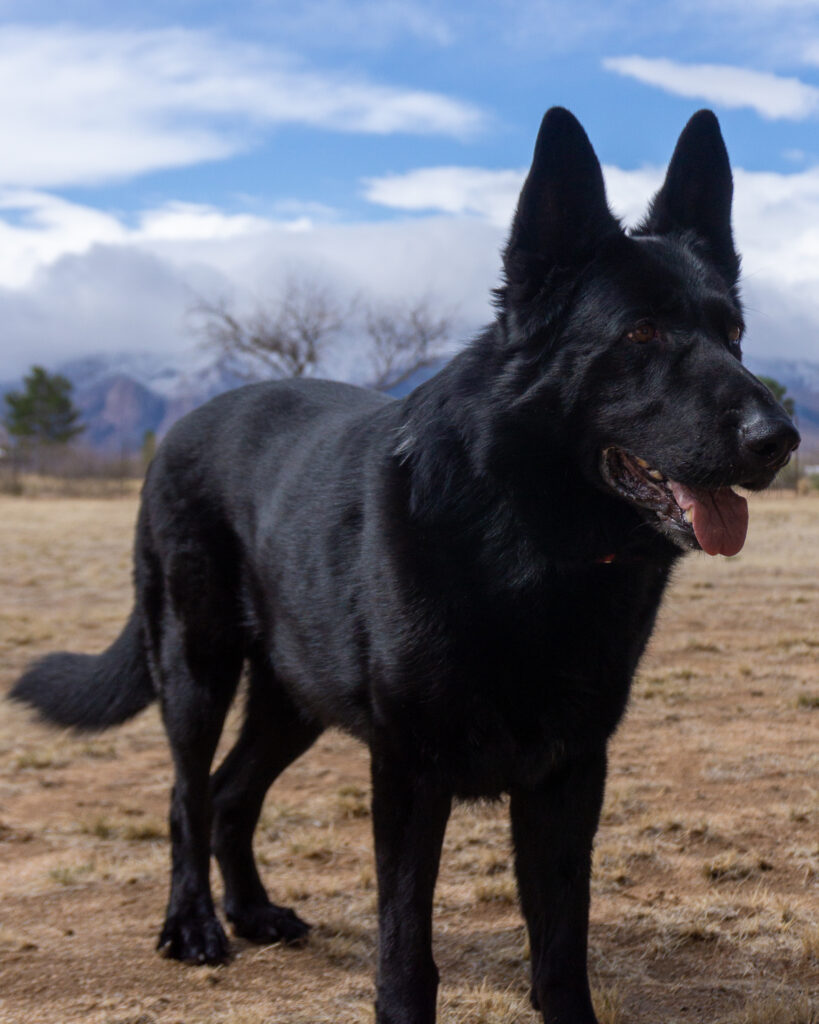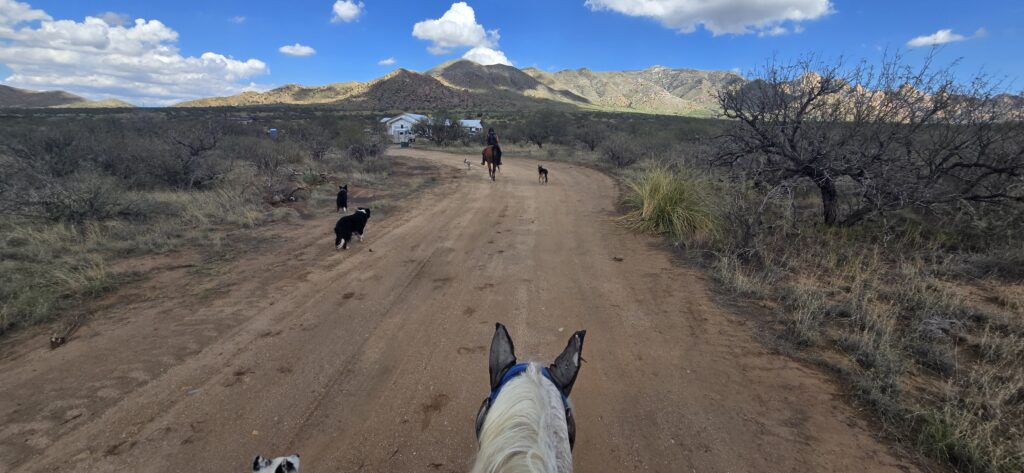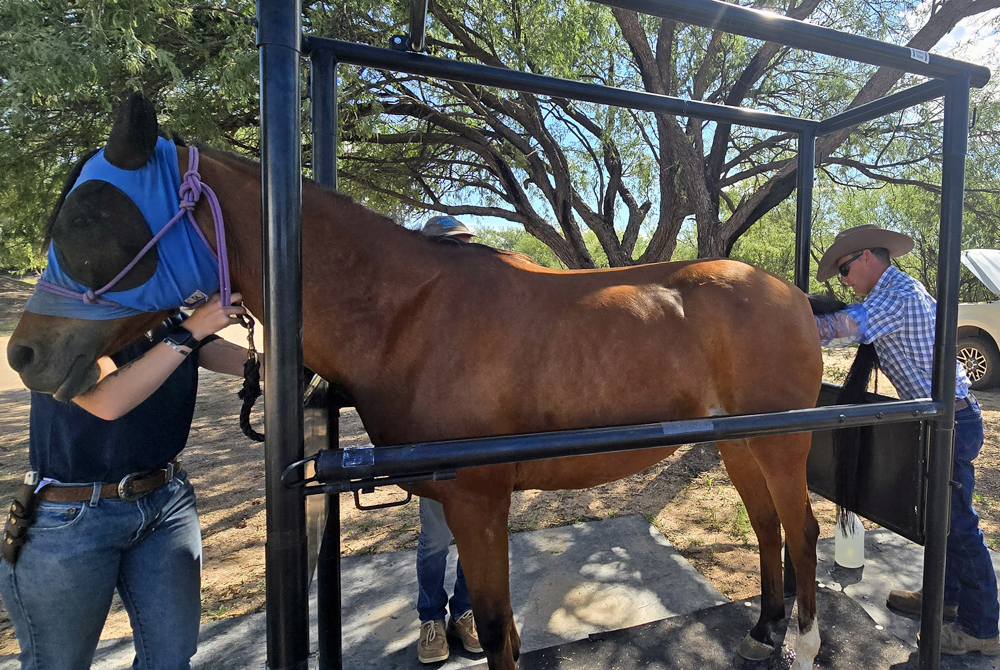During veterinary school, the vast majority of equine colics we witnessed at the Purdue Large Animal Clinic had the potential to become surgical cases. For the most part, only the worst of the worst were referred to the vet school. Therefore, every time one of my own horses colicked, I had to remind myself that most colics are handled in the field—and often with good results.
That being said, I’ve lost too many horses to this dreaded equine scourge. Sadly, our most recent loss was just a week ago. We woke up Friday morning and noticed Sadie lying down by the fence. Normally, she and Kadeen would be at the gate, waiting for Alan to serve breakfast. My heart skipped a beat when I saw her down. I watched through the window, relieved when she got up and trotted toward Alan and Kadeen.

That momentary peace was shattered just minutes later when Alan’s ringtone broke the silence. I knew instantly that we were in trouble. As soon as I answered, his voice, thick with emotion, told me that Sadie was down again and rolling. I grabbed my stethoscope and some Banamine and headed straight to the barn.
I heard a little bit of gut activity, but not much. I gave her IV Banamine and called my vet. We were able to trailer her to his clinic, where he tubed her and administered a laxative along with gut-relaxing medications. He also performed an ultrasound and noted some mucosal changes. However, there were no obvious torsions or blockages, and she had normal feces in her rectum.
Throughout the rest of the day, we walked her every couple of hours to help stimulate her GI tract. Current thinking on managing a colicky horse recommends walking for 10 minutes every two hours. I found this outstanding article outlining the dos and don’ts of equine colic. Although I’m a veterinarian, my experience is in small animal medicine. And honestly, when one of my own animals is in crisis, my brain tends to go on vacation.
Sadie received another dose of IV Banamine that evening. Although she was clearly uncomfortable, it wasn’t as intense as what I’d seen in the past. I remembered a 24-year-old Babson mare I lost in the late ’90s. My equine vet had pumped her full of meds, but we couldn’t touch her pain. Our options were limited, and the decision was clear. That mare belonged to the Babson farm and was on “permanent loan.” I vividly recall my conversation with John at the farm—he was the ultimate decision-maker. Neither of us felt that surgery made sense for that old mare.
We checked on and walked Sadie again before bed, and then between 2:00 and 3:30 in the morning. She had passed a few fecal balls late Friday, but not a meaningful amount. Her condition was essentially unchanged during the 3:00 AM evaluation. At 6:30 AM, Alan found her deceased. She was lying across the bar at the base of the stall door, which is about four inches off the ground. It appears she collapsed at that spot.
I was inside, preparing to draw another syringe of Banamine, when Alan walked through the back door. I have no words to adequately describe the look on his face. He said nothing.
“Well?” I asked.
Still nothing.
“How is she doing?!” I pressed.
Silence.
I was sharper the third time: “Alan, tell me—what’s going on?”
“She’s gone.”
The inevitable second-guessing game
From the onset of symptoms to her death, it was roughly 24 hours. My equine vet hadn’t expected the news I gave him Saturday morning. Nothing that he had observed on Friday led him to believe things would progress that quickly. Needless to say, neither Alan nor I had any expectation of finding her dead just three hours after our last check. Should we have camped out in her stall all night? Maybe… but I keep asking myself: what could I have done differently? I hate that she died with no one there but Kadeen, but what could I have done?
Sadie was 19 years old, and I wouldn’t have put her through colic surgery. I often see conversations on Facebook about whether or not to pursue surgery in these cases. My vet said on Saturday that clearly she would have needed surgery, given how quickly things progressed. But we’re in the middle of nowhere, and honestly, I don’t even know where people around here take horses for colic surgery. Gone are the days of living just an hour from Colorado State University or Purdue.
While financial constraints can’t be ignored, we’ve made costly surgical decisions before. Kadeen’s value increased by $7,000 after undergoing surgery for a puncture wound and fractured splint bone. But for me, the decision is less about money and more about what I’m willing to put my animals through.
If she was gone within 24 hours—and my vet didn’t even hint that surgery might be necessary—it’s clear that, even if we’d wanted to pursue that option, it all happened too fast.

When we lost our black German Shepherd, Mica, in the spring of 2024, we faced another one of those “gray area” decisions. It was suspected he had osteosarcoma, though we never could confirm a definitive diagnosis. My local small animal vet friend recommended amputating his leg. We weighed the impact that would have on Mica against what we might gain—and ultimately decided it wasn’t a balanced trade.
What does Google AI say about the statistics of equine colic surgery?
A quick query to Google provides the following interesting statistics:
Statistics for equine colic surgery show a significant survival rate, with 74% to 85% surviving the procedure itself, and 63% to 85% returning to athleticism. However, approximately 4–10% of all colic cases require surgery, and the success can depend on factors like age, the specific type of lesion, and how quickly the horse receives treatment. Post-surgery complications, such as incisional infections, can also occur in a higher percentage of cases compared to other types of surgery.
Survival rates
- Surgical survival: 74–85% of horses survive the surgery itself.
- Long-term survival: A long-term survival rate of 66–91% (up to 1 year after surgery) is reported, with one study showing 85.9% survival at 1 year after discharge.
- Return to athleticism: 63–85% of horses return to some level of athleticism.
Prevalence and factors
- Prevalence: 4–10% of all colic cases require surgery.
- Short-term survival: One study found a short-term survival rate of 76.7% for horses that underwent surgery.
- Factors: Survival and recovery can be influenced by a horse’s age, the type of intestinal lesion (e.g., strangulating vs. non-strangulating), the duration of the surgery, and how quickly the horse receives treatment.
Risks and complications
- Incisional infection: This is a more common complication after colic surgery compared to some other procedures, with rates potentially as high as 43% in some studies.
- Other complications: Other potential complications include edema, hernia, and dehiscence (wound separation).
So what comes next?
I struggled all day Friday with how much—or how little—to prepare Alan for the realities of colic. I didn’t want to sound doom and gloom, but I also knew that a horse with a bellyache is never something to take lightly. Still, I figured that even if things went south, we’d have time to make decisions and process it.
We didn’t. Our heads were spinning with what had just happened. Sadly, so was Kadeen. His cries for Sadie and his obvious loneliness added another layer of heartbreak. We had always expected 23-year-old Kadeen to be the first to go. In fact, we’re building a three-stall barn at our new home, with plans to add another horse next year. We were hoping to avoid finding ourselves in this position—down to one lonely horse. We had planned to adopt from Love This Horse Equine Rescue (LTH).
LTH has recently placed many of their horses, and at the moment, none of the available ones meet our needs. The staff is just beginning work with a group of eight bays. Alan and I considered taking one of their sanctuary horses—rideable but not adoptable—as a temporary companion until the right one came along.
While weighing our options, we also looked into horses available in our general area. Last Wednesday, we made a trip to Phoenix to check out three horses for sale and one that was offered either for a care lease or purchase. The care lease horse could have worked as an interim ride, and he was closer to home than coordinating with Vera at LTH to get a sanctuary horse. As we left the farm where the care lease horse lived, we agreed: unless we truly fell in love with one of the sale horses we were about to see, we’d wait for LTH to help us find our next trail partner. Well… the best laid plans…
Introducing Rana, which means “eye-catching,” suitable for a mare that captures attention
Rana is a 9-year-old mare, half Arabian and half Quarter Horse. She’s had extensive training and responds to many of the same “buttons” as my once-showhorse gelding. We bought her for Alan, but I’ll be putting trail miles on her since she’s been primarily an arena horse. I was the one who put all the trail miles on Kadeen.
Rana settled in quickly, and Kadeen is once again a happy, contented boy. He was definitely depressed at being alone. It’s clear from this video that Rana hasn’t worn fly leggings before!
We still intend to adopt a third horse from Love This Horse. We don’t want to be scrambling again—but for now, we (hopefully) have time to wait for the right one. We’ll be moving into our new home sometime after the first of the year. We’ve already trailered to the property and ridden from there, and we have round pens set up to contain the horses if needed.
We haven’t sold our current home yet, so there’s no immediate need to live in our motor coach on-site. The barn is set to be finished this week, but we still need utilities installed to make “glamping” in the motor coach a viable long-term option!

Hug your horses… You never know when that dreaded bellyache will become a catastrophic loss.










